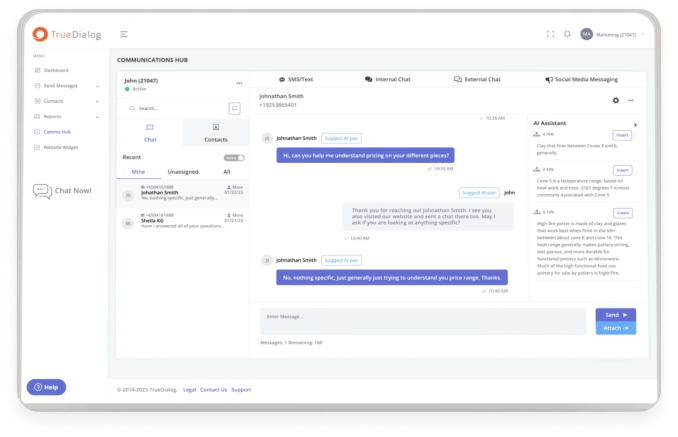Clients can complete the application and get approved in days instead of weeks—transforming a previously manual process.
Austin, TX – August 06, 2024 – TrueDialog, a leading provider of enterprise-grade SMS texting solutions, today announced the launch of its Automated 10DLC Registration feature, which will transform how soon businesses begin their texting campaigns. This innovative solution streamlines the manual registration process required for brands to send long-code text campaigns, reducing approval times significantly. With TrueDialog’s Automated 10DLC Registration, clients are compliant in days instead of weeks. This is especially timely as mobile carriers are expected to begin blocking unregistered traffic in late 2024.
According to Mobile Marketing Watch, SMS text messages have an open rate of 98%. But in order to be opened, they need to be successfully delivered. The Campaign Registry (TCR) is an independent reputation authority founded in 2020 by the largest U.S. mobile network operators. It is a centralized hub for collecting brand and campaign data, enabling mobile carriers to protect customers from SPAM text messages.
Mobile carriers have SPAM filters to protect recipients from unwanted or fraudulent messages, and TCR registration is an increasingly vital step to ensure message deliverability. In addition, carriers can ban companies for texting or calling with an unregistered number, and they fine brands up to $10 per text message sent by an unregistered 10DLC.
Many businesses face challenges with the manual registration process, which often takes weeks or months. TrueDialog’s Automated 10DLC Registration feature simplifies this journey, allowing their clients to register campaigns swiftly through an intuitive user interface. Clients input essential business information, including their Employer Identification Number (EIN), select usage scenarios via a drop-down menu, and provide message examples. A TrueDialog expert is happy to guide the client’s registration application process during onboarding and beyond.
“We’ve eliminated the complexity and time-consuming nature of traditional 10DLC registration,” said Navid Ashroff, CTO of TrueDialog. “Now, our clients can complete the application process in less than ten minutes, with approval times averaging three to five days—a significant improvement over industry norms. This enables them to realize business value much faster, launching their SMS campaigns in days, not months, while maintaining compliance.”
TrueDialog’s Automated 10DLC Registration feature is built on extensive customer feedback and industry insights gathered since the introduction of 10DLC two years ago. The platform expedites initial carrier vetting, supports ongoing campaign scalability, and does not mark up the carrier fees.
Related:
TrueDialog Introduces TrueDelivery, the First SMS Deliverability Scoring Tool for Business Texting
About TrueDialog
TrueDialog powers Enterprise-Grade SMS Business Text Messaging for revenue teams to drive engagement across the customer lifecycle, and at scale. Founded in 2008, TrueDialog is a Communications-Platform-as-a-Service (CPaaS) company serving over 2,000 customers in North America that continues to innovate its messaging platform to ensure its leadership position in the industry. The technology is cloud-based and API-centric, powered by an ISO 9001 database and direct carrier connections to deliver 99.9% uptime. Customers use TrueDialog for text message marketing, mass text messaging campaigns, customer service text messaging, and employee communication. For more information, visit TrueDialog.com.
Contact (For Media Only):
Jodi Bart Holzband
Classic Bart PR & Communications
jodi@classicbart.com

